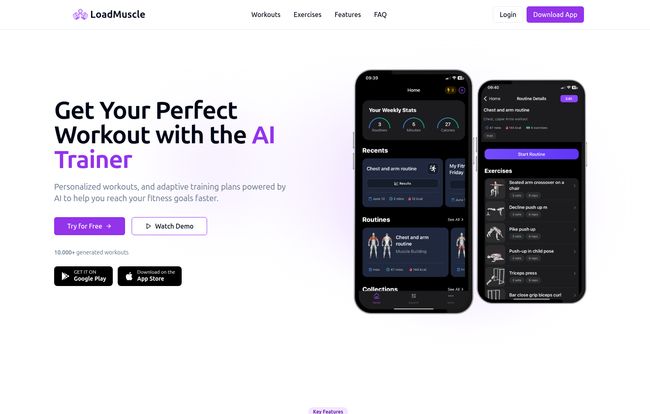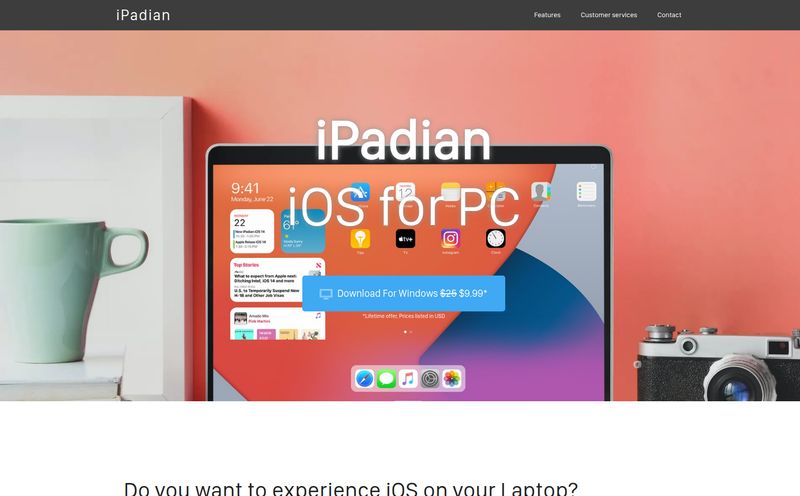We’ve all been there. Staring at the rows of dumbbells and racks of machines in the gym, feeling a mild sense of panic. What should I do today? Am I doing this right? Is this even working? The classic gym-timidation. Or maybe you're at home, surrounded by a random assortment of resistance bands and a yoga mat, scrolling endlessly for a workout that doesn’t feel like it was designed for a superhero.
For years, the answer has been either hiring a pricey personal trainer or winging it with a generic, cookie-cutter plan you found online. But the tech world, as it does, has offered up a new contender: The AI-powered trainer. And today, we’re looking at one that’s been making some noise: Load Muscle.
I’ve seen dozens of fitness apps come and go, each promising to be “the one.” Most are just glorified PDFs with a stopwatch. So, when I hear “AI-powered,” my inner SEO and tech nerd gets curious, but my seasoned gym-goer side stays skeptical. Can an algorithm really replace the intuition of a human coach? Let’s find out.

Visit Load Muscle
So, What is Load Muscle, Exactly?
At its core, Load Muscle is an AI workout generator. Think of it as a pocket-sized personal trainer who’s also a bit of a data scientist. You tell it your goals, what equipment you have (or don’t have), and your fitness level. In return, it doesn't just hand you a static plan. It builds one for you, and more importantly, it claims to adapt that plan based on your performance. It's designed to be the brains behind your brawn, handling the “what” and “why” so you can focus on the “how.”
The AI Trainer Promise: More Than Just a Smart To-Do List
The big selling point here is the “AI Trainer.” This isn't just about picking exercises from a list. The platform says it actively learns from your workouts. Did you breeze through those three sets of squats? The AI might suggest adding more weight or reps next time. Struggling with push-ups? It can suggest an alternative exercise, like incline push-ups, to help you build strength progressively.
One thing that caught my eye was its ability to adjust based on available equipment. This is a game-changer. I’ve been in crowded gyms where every single bench is taken. The ability to tell an app, “Hey, the bench press is occupied,” and have it instantly suggest an equally effective alternative like dumbbell floor presses… that’s genuinely useful. It removes the friction that often leads to a half-baked workout. It's a small detail, but it shows a deeper understanding of the actual gym experience.
The Core Features That Actually Matter
An app can have all the fancy bells and whistles, but what actually helps you get results? I dug into Load Muscle’s main offerings.
Personalized Plans vs. Pre-made Workouts
The app offers two paths, which I appreciate. You can either go all-in on the AI and get a fully personalized plan tailored to your goals—whether that’s strength training, HIIT cardio, or improving mobility—or you can choose from a library of pre-made workouts. This is smart. Some days, you want a plan that’s meticulously crafted for you. Other days, you just want to jump into a quick “Tabata Challenge” or a “Rest Day Yoga” session without overthinking it. It provides both structure and flexibility.
An Exercise Library That Puts Others to Shame
Okay, this part is impressive. Load Muscle boasts a library of over 6,000 exercises, each with a GIF. Six thousand. Let that sink in. The inclusion of animated GIFs is, in my opinion, non-negotiable for a modern fitness app. Reading a description of a “barbell tri bench press” is one thing; seeing a short, looped video of the correct form is another. This is crucial for effectiveness and, more importantly, injury prevention. I've seen some pretty creative—and terrifying—interpretations of exercises in my day, and anything that helps people nail their form gets a huge thumbs-up from me.
Tracking That Tries to Motivate
Of course, it tracks your progress. Reps, sets, weight, you name it. But it also tries to be your cheerleader. The homepage mentions it “celebrates your achievements and celebrates your milestones.” While this can sometimes feel a bit corny in other apps, it's a necessary component of habit formation. Seeing a graph trend upwards or getting a little digital high-five for a new personal record provides a dopamine hit that can be the very thing that gets you to show up on a day you’d rather not.
Who is This App Really For?
I see this app fitting a few different profiles perfectly:
- The Beginner: Someone new to the gym who feels overwhelmed and needs clear guidance on what to do and how to do it. The exercise library alone is worth its weight in gold for this group.
- The Busy Professional: Like “Sarah Chen” from their testimonials, who needs an efficient, no-nonsense workout she can knock out in 30 minutes. The AI takes the planning out of the equation.
- The Intermediate Lifter: Someone who’s been working out for a while but has hit a plateau. The adaptive nature of the AI could be just the thing to introduce progressive overload in a new, intelligent way.
The Good, The Bad, and The AI
No tool is perfect, right? After poking around, I’ve got some thoughts. I quite like the potential here; the personalized plans and AI-driven adjustments feel like the next logical step for fitness tech. Having a huge library of exercises with clear animations is a massive plus, and the pre-made workouts are great for days when you just want to get in and get out. It really does seem to cover all the bases for creating a solid routine.
However, you have to be honest with it. The AI is only as good as the data you give it. If you say you completed 10 reps when you only managed 6, you're only cheating yourself and the effectiveness of the program. It requires discipline. Also, while the website shows prominent links to the App Store and Google Play, some earlier info I found mentioned a mobile app was 'coming soon'. This suggests a very recent launch, which can sometimes mean a few bugs are still being ironed out, so that's something to keep an eye on. Finally, some people just don't want to rely on an algorithm for their fitness. They prefer the organic, intuitive approach, and that’s perfectly fine too.
What's the Damage? A Look at Pricing
Here’s the million-dollar question. Or, hopefully, the not-so-many-dollars question. I clicked on their pricing page and… got a friendly “Ah, dang. We didn’t find that page.” This isn’t uncommon for app-first services. Typically, this means the pricing structure—likely a monthly or annual subscription, possibly with a free trial—is handled directly within the app itself once you download it. I’d expect it to be in line with other premium fitness apps on the market. You'll have to download it to see the specific tiers.
Your Questions Answered
How do you get started with Load Muscle?
You download the app, create an account, and then input your goals, experience level, and what equipment you have access to. The AI takes it from there to build your initial plan.
Can I use this at home with no equipment?
Yes. When setting up your profile, you can specify that you're working out at home with little or no equipment, and the AI will generate bodyweight-focused routines for you.
How smart is the AI, really?
It's based on your feedback. It adjusts future workouts by analyzing the difficulty you report for current exercises, your consistency, and your progress over time. The more you use it and the more accurate you are, the smarter it gets.
What if I want to cancel my subscription?
Like most app-based subscriptions, you can typically manage and cancel it directly through your phone’s App Store or Google Play Store account settings at any time.
Is there a community or support feature?
The site has a standard contact/support form for technical issues. While not explicitly mentioned as a community hub, the shared experience of following AI-driven plans is a connecting factor for its users.
My Final Verdict on Load Muscle
So, is Load Muscle the future of fitness? Well, it's certainly a strong step in that direction. It neatly solves some of the most common problems people face with their fitness routines: lack of knowledge, lack of a plan, and hitting plateaus.
I'm genuinely intrigued by its adaptive AI. It's not just a content library; it's a dynamic tool that aims to grow with you. For anyone who craves structure, data-driven progress, and a plan that feels like it was made just for them, Load Muscle is definately worth a download. It takes the guesswork out of working out, which for many people, is more than half the battle.
At the end of the day, the best workout plan is the one you can stick to. By making fitness more accessible, personalized, and intelligent, Load Muscle has a real shot at being that plan for a lot of people.
References and Sources
- Load Muscle Official Website
- Physical Activity Guidelines for Americans (health.gov) - For context on the importance of structured exercise.



